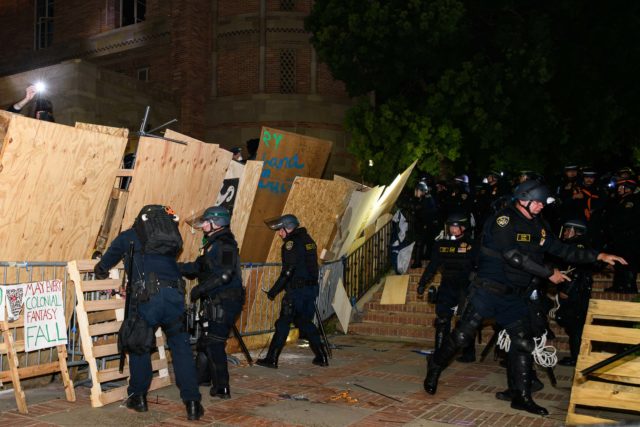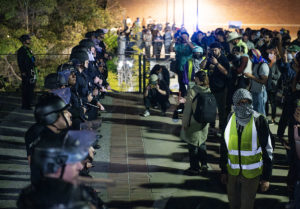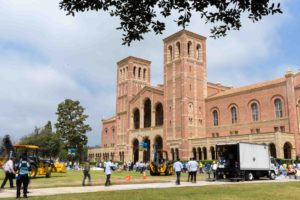This post was updated May 14 at 11:41 p.m.
Experts on policing and civil rights law condemned law enforcement’s use of force during the police-led sweep of the Palestine solidarity encampment and its subsequent arrest of pro-Palestine protesters.
Law enforcement agencies, led by UCPD and including LAPD, swept the encampment early in the morning of May 2, arresting more than 200 students. Officers used flash bangs, rubber bullets, batons and tear gas on protesters to breach the encampment. The forceful sweep followed aggressors violently attacking the encampment the night before, assaulting pro-Palestine protesters by throwing fireworks and tear gas into the area for over three hours without police intervention.
Michael Sierra-Arévalo, a professor of sociology at the University of Texas at Austin, said UCLA’s administration and UCPD should have worked harder to deescalate the situation and communicate with the encampment’s organizers before using force. Research in crowd psychology and police response shows that negotiation is the best approach to handling protests, added Sierra-Arévalo, author of the book “The Danger Imperative: Violence, Death, and the Soul of Policing.”
Because police officers receive minimal training on how to address protests, they often resort to what they are trained in the most, which is the threat and use of violence, Sierra-Arévalo said. However, the amount of force used at UCLA was a stark escalation from how police departments on university campuses normally act in response to peaceful protests, he added.
“You don’t preemptively escalate to full riot gear, helmets, shields, shin guards, pepper spray,” Sierra-Arévalo said. “That is actually creating a circumstance that is much more likely to result in violent conflict and is not conducive to avoiding the escalation of protest.”
Some experts alleged that certain police actions at UCLA violated state law. Carol Sobel, a civil rights attorney, said the police’s use of excessive force on peaceful protesters violated Assembly Bill 48, which states that law enforcement agencies in California can only use less-than-lethal ammunition if someone violently resists arrest or presents an immediate threat of serious harm.
Less-than-lethal rounds still have the potential to cause serious injury, Sierra-Arévalo said. At a Faculty for Justice in Palestine at UCLA press conference Thursday outside of Charles E. Young Research Library, a medic who treated patients the night of the sweep said they evaluated over a dozen students for rubber bullet injuries, such as bone fractures, golf-ball sized contusions, and eye, scalp, face and body lacerations.
“It’s less likely to be lethal, but it’s not non-lethal,” Sierra-Arévalo said. “What’s not clear to me is that what was happening on the UCLA campus or on other campuses was anywhere near the level of physical resistance that I, as an expert in policing, or frankly, what a reasonable officer would think is necessary.”
In addition to the excess use of force, Sierra-Arévalo questioned the length of time it took for UCPD and LAPD to respond to aggressors’ violent April 30 attack of the encampment. The attack began around 10:50 p.m., when counter-protesters started throwing fireworks and tear gas into the encampment. Vice Chancellor for Strategic Communications Mary Osako said at 12:12 a.m. in a statement that law enforcement had been called for immediate support. However, police did not intervene until more than two hours later.
Nearly a week after protesters were arrested during the encampment sweep, police officers also arrested 44 people – including pro-Palestine protesters, community members, legal observers and non-Daily Bruin journalists – before a planned sit-in at Moore Hall on May 6. Protesters in the group were in possession of metal pipes, bolt cutters and epoxy adhesives, according to a statement by UCPD.
One reason those arrested May 6 were cited with conspiracy to commit burglary rather than trespassing could be that police wanted to acquire search warrants for their phones, said Susan Seager, an adjunct professor of law at UC Irvine.
“I’m concerned that the police are getting and maybe have already gotten search warrants to search the phones based on this supposed conspiracy among the students to commit burglary,” she said. “It’s a complete overreach and abuse of power.”
UCPD arrested a freelance journalist along with the protesters, which Seager said she believed was unlawful under Penal Code 409.7, which allows authorized members of the press to go past police and skirmish lines when reporting. She added that it would also be illegal to search the journalist’s phone.
“It defies belief that he was engaged in a conspiracy to commit a burglary when he was simply filming UCLA police in a public parking lot,” she said in an email to UCPD acquired by the Daily Bruin. “UCLA should ask the LAPD to release him immediately and withdraw the citation against him.”
As the university tries to move forward, UCLA administration, UCPD and LAPD should be transparent about who made the decisions to deploy force, Sierra-Arévalo said. In response to last week’s events, Chancellor Gene Block announced the creation of the Office of Campus Safety led by newly-appointed vice chancellor Rick Braziel, which would take over management of the UCPD from Administrative Vice Chancellor Michael Beck’s office.
“I would like an accounting of who made decisions when and why, and that should cut across the university,” Sierra-Arévalo said. “It should cut across the UCPD on the UCLA campus. It should cut across the LAPD and any other agencies involved.”






Comments are closed.